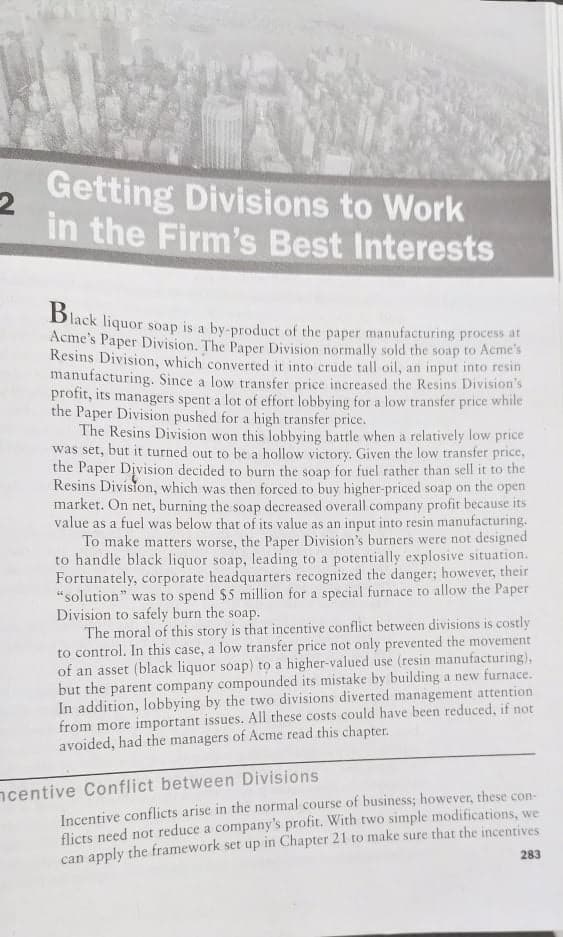Based on the topic in the picture, what are the key points there that you think are important to analyze as a decision-maker?
Based on the topic in the picture, what are the key points there that you think are important to analyze as a decision-maker?
Chapter1: Taking Risks And Making Profits Within The Dynamic Business Environment
Section: Chapter Questions
Problem 1CE
Related questions
Question
Based on the topic in the picture, what are the key points there that you think are important to analyze as a decision-maker?

Transcribed Image Text:Getting Divisions to Work
in the Firm's Best Interests
Dlack liquor soap is a by-product of the paper manufacturing process at
Acme's Paper Division. The Paper Division normally sold the soap to Acme's
Resins Division, which converted it into crude tall oil, an input into resin
manufacturing. Since a low transfer price increased the Resins Division's
profit, its managers spent a lot of effort lobbying for a low transfer price while
the Paper Division pushed for a high transfer price.
The Resins Division won this lobbying battle when a relatively low price
was set, but it turned out to be a hollow victory. Given the low transfer price,
the Paper Division decided to burn the soap for fuel rather than sell it to the
Resins Division, which was then forced to buy higher-priced soap on the open
market. On net, burning the soap decreased overall company profit because its
value as a fuel was below that of its value as an input into resin manufacturing.
To make matters worse, the Paper Division's burners were not designed
to handle black liquor soap, leading to a potentially explosive situation.
Fortunately, corporate headquarters recognized the danger; however, their
"solution" was to spend $5 million for a special furnace to allow the Paper
Division to safely burn the soap.
The moral of this story is that incentive conflict between divisions is costly
to control. In this case, a low transfer price not only prevented the movement
of an asset (black liquor soap) to a higher-valued use (resin manufacturing),
but the parent company compounded its mistake by building a new furnace.
In addition, lobbying by the two divisions diverted management attention
from more important issues. All these costs could have been reduced, if not
avoided, had the managers of Acme read this chapter.
ncentive Conflict between Divisions
Incentive conflicts arise in the normal course of business; however, these con-
flicts need not reduce a company's profit. With two simple modifications, we
can apply the framework set up in Chapter 21 to make sure that the incentives
283
Expert Solution
This question has been solved!
Explore an expertly crafted, step-by-step solution for a thorough understanding of key concepts.
Step by step
Solved in 2 steps

Knowledge Booster
Learn more about
Need a deep-dive on the concept behind this application? Look no further. Learn more about this topic, management and related others by exploring similar questions and additional content below.Recommended textbooks for you

Understanding Business
Management
ISBN:
9781259929434
Author:
William Nickels
Publisher:
McGraw-Hill Education

Management (14th Edition)
Management
ISBN:
9780134527604
Author:
Stephen P. Robbins, Mary A. Coulter
Publisher:
PEARSON

Spreadsheet Modeling & Decision Analysis: A Pract…
Management
ISBN:
9781305947412
Author:
Cliff Ragsdale
Publisher:
Cengage Learning

Understanding Business
Management
ISBN:
9781259929434
Author:
William Nickels
Publisher:
McGraw-Hill Education

Management (14th Edition)
Management
ISBN:
9780134527604
Author:
Stephen P. Robbins, Mary A. Coulter
Publisher:
PEARSON

Spreadsheet Modeling & Decision Analysis: A Pract…
Management
ISBN:
9781305947412
Author:
Cliff Ragsdale
Publisher:
Cengage Learning

Management Information Systems: Managing The Digi…
Management
ISBN:
9780135191798
Author:
Kenneth C. Laudon, Jane P. Laudon
Publisher:
PEARSON

Business Essentials (12th Edition) (What's New in…
Management
ISBN:
9780134728391
Author:
Ronald J. Ebert, Ricky W. Griffin
Publisher:
PEARSON

Fundamentals of Management (10th Edition)
Management
ISBN:
9780134237473
Author:
Stephen P. Robbins, Mary A. Coulter, David A. De Cenzo
Publisher:
PEARSON